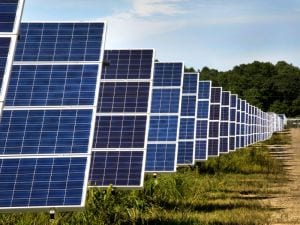Construction of a 19MW solar farm in Victoria’s north-west is expected to start within weeks, after the project was underwritten by Australian funds manager Impact Investment Group, in what is expected to become one of the seed assets of a new, separate solar fund.
IIG – whose renewables portfolio is headed up by former Pacific Hydro chief, Lane Crockett – revealed its intentions, in March, to invest $1 billion in renewable energy generation and infrastructure over the coming three years.
The $32 million Swan Hill Solar Farm was unveiled on Tuesday as the fund’s largest solar investment, to date, and – on completion – is expected to become one of the seed assets in a new IIG solar fund, the details of which the company said would be released in due course.
It will have more than 50,000 solar panels operating on a single axis tracking system, and is expected to produce 37,700MWh in its first year of operation, enough to power the equivalent of around 6,300 Australian homes.
At 19MW, the Swan Hill Solar Farm, which will be developed by Australian Solar Group, is also expected to be one of the highest capacity solar farms in Victoria on completion – although it won’t hold that title for long.
Other projects being developed in the region include the Gannawarra Solar Farm, the first 60MW of which is being co-developed by Solar Choice and Edify Energy on the 220kV transmission line between Swan Hill and Kerang, backed by a PPA from EnergyAustralia.
And in June, battery storage developer Lyon Group unveiled plans for a 250MW large-scale solar plant, paired with 80MW/160MWh of battery storage at Nowingi, also in the state’s north-west.
“It is great to be a prominent part of this new wave of construction and investment in Victoria’s solar energy economy,” said IIG CEO Chris Lock, in comments on Monday.
“This project demonstrates that IIG can create investment opportunities in solar assets even during times of policy uncertainty for Australian energy markets. Many sophisticated investors recognise that the world is shifting to renewable power such as wind and solar.
“Investing in solar power stations can deliver investor returns, create jobs and provide cleaner, safer, healthier energy options,” Lock said.
Mayor of Swan Hill Rural City Council, Les McPhee, said north west Victoria was primed to be a centre for clean energy generation.
“Investments like this one from the Impact Investment Group are game-changers for our move to a renewable energy economy, and Swan Hill is proud to have secured one of the first large-scale solar farms in Victoria,” McPhee said.
“Council has been an early supporter of solar energy and has enjoyed a great relationship with the developers and investors of this solar farm at what is locally known as Blackwire Reserve.”
With funding secured, construction is expected to begin later this month, creating 60 jobs during development, and the same number again through indirect employment in the supply chain.
RCR Tomlinson has been awarded the engineering, procurement, construction and maintenance contract for the project, including associated substations and grid connection works.
Once commissioned, RCR will undertake maintenance services for an initial period of two years.











